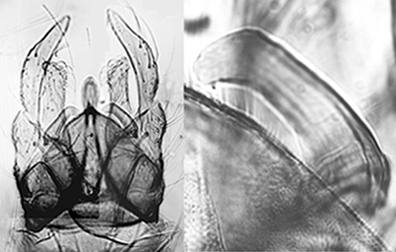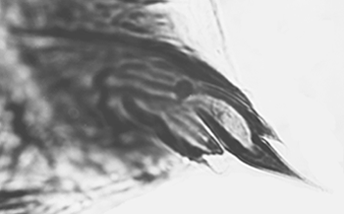Species 2e. C. (Lobochironomus) ?nr. austiniAdult:
The adults and rearings of this species are in the James E. Sublette collection, in the Museum of the University of Minnesota, St. Paul, MN.
Only photographs of the male terminalia and the SVo are available for study. These suggest that the color may be similar to that of C. austini, or perhaps darker. 
Male hypopygium (left) and superior volsella (right) of C. (Lobochironomus) ?nr. austiniIt appears there are setae in individual clear spots on TIX. The anal point is narrowed at the base and comes to a point at the distal end. The Inferior volsella reaches beyond the end of the anal point to about the middle of the gonostyle which is only moderately swollen and narrows relatively gently over the distal third. The setae of the IVo are probably simple.Pupa:
This specimen is in the Sublette collection as it is associated with reared M1. The caudolateral spurs on segment VIII have one major spine and one or two smaller ones flanking it. 
Caudolateral spur of C. (Lobochironomus) ?nr. austiniFourth instar larva a small thummi-type (length, fem. 12.2 (10.1-13.5) mm; male about 9.4 mm); posterior pair of ventral tubules usually longer (ant 0.85 (0.69-1.02 mm; post. 0.94 (0.82-1.19 mm). Anal tubules about 4 times longer than wide, ventral pair thicker. Gula and frontoclypeus pale. Gula and frontoclypeus pale.
Mentum (Fig. d) with somewhat rounded teeth; c1 tooth relatively narrow and rounded, c2 teeth well separated and quite tall (type IV); 4th laterals sometimes slightly reduced (type I-ii).
Ventromentum (Fig. e) about 196.3 (186.5-207) µm wide and 3.17 (2.96-3.42) µm deep, and 1.13 (1.07-1.18) times the mentum width; with about 39-41 striae; VMR 0.21 (0.20-0.22). Pecten epipharyngis (Fig. b) with about 19 (17-23) teeth, including many small teeth.
Premandible (Fig. c) with equally long broad teeth, inner tooth about inner tooth about 2.9 (2.7-3.35) times wider than the outer tooth (Ty. E).
Antenna (Fig. a) with basal segment 3.8 (3.3-4.3) times wider than long, Ring organ about 40 (30-45)% of way up from base; AR about 1.84 (1.67-1.90); 3rd segment longer than 4th or 5th segment; segment proportions (microns): 126 : 33.5 : 13.5 : 12 : 8.
Distance between antennal bases ((125-172 µm) greater than that between setae S4 (117-143), which are separated by about 0.72 (0.69-0.76) of the width of the FC at that point.
Mandible (Fig. f) with third inner tooth poorly to moderately separated and with some coloration (type I-IIA-B); about 18.7 (18-20) furrows on outer surface at base and 13.75 (13-14) setae in pecten mandibularis; Mdt-Mat about 25.5 (23-28); MTR about 0.33 (0.29-0.37). Cytology: 4 polytene chromosomes with the thummi arm combination AB, CD, EF, G. Keyl pattern difficult to distinguish because of lack of pairing in many areas.
Arm G unpaired with a subterminal nucleolus and a Balbiani ring (BR) near the other end. No nucleoli in the long chromosomes.
Polymorphism in arms B and F.
Arm A1:
Arm B1: No obvious puff/BR.
Arm B2: Small inversion of distal third of arm.
Arm C1: Band groups 2-4 not readily obvious
Arm D1:
Arm E1:
Arm F1:
Arm F2: differs from F1 by simple inversion about one third from distal end
Arm F3: differs from F1 by a complex inversion of distal third of arm Found: Ontario - 2 ml e. Morven. Snow melt pool with thick leaves and some algal growth. The larval characters of this species correspond relatively well with Epler's (2001) description of C. (Lobo.) austini, but the adult has a much more robust superior volsella and the pupal spur has multiple spines. See also C. (Lobo.) austini, C. (Lobo.) dorsalis, C. (Lobo.) storai, C. (Lobo.) pseudomendax and C. (Lobo.) species 4v.| Return to Index| Go to References ] | 
